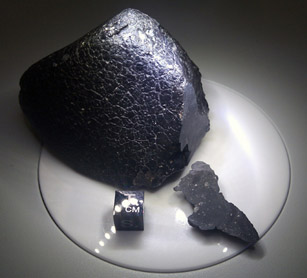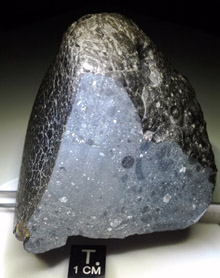Tests show that the meteorite known as NWA 7034 formed on Mars some 2.1 billion years ago and that it's unique among the known Martian meteorites in several geochemical respects.
There was a time when every discovery of a meteorite from Mars made news. Now, it's hardly ever the case, mostly because the count of known Martian meteorites has soared to 113 (as of today). One exception is Tissint, a scattering of stones that eyewitnesses saw fall from the sky over southern Morocco in mid-2011. Meteoriticists rejoiced at getting such a fresh sample, before it could suffer contamination from sitting around on Earth.

The Martian meteorite known as Northwest Africa (NWA) 7034 was discovered in Morocco in 2011. Geochemists believe it is a 2-billion-year-old sample of the Red Planet's crust. The small cube is 1 cm (0.4 inch) on a side.
Carl Agee / Univ. of New Mexico
Here's another: It's known as Northwest Africa 7034, a single stone found by savvy Moroccan nomads in 2011. With a mass of 320 g, NWA 7034 has a smooth exterior and a beautifully textured black fusion crust. But it's what geochemists Carl Agee (University of New Mexico) and 15 others found inside during a year of analysis that earned a generous 9 pages for their report in today's online edition of Science.
There are four things about this meteorite that make it very special.
First, it's a fused assemblage of bits of basalt that contains some sizable individual crystals. Such basaltic breccias form from quickly cooling lava — a trait common in samples from the Moon, but a first for a meteorite from Mars. And whereas virtually every known Martian stone is "a mismatch for much of the Martian crust exposed at the surface," according to the Science team, NWA 7034 has an elemental makeup "strikingly similar" to the Red Planet's surface, as determined by the orbiters and landers there. It's very likely a chunk of the Martian crust.
Second, NWA 7034 has an crystallization age, deduced from multiple isotopic-dating tests, of 2.1 billion years. Again, this makes it unique. All other Martian meteorites are either an extremely old 4+ billion years or an extremely young 180 million years. But NWA 7034 is in between, having formed at a time when Mars had settled into middle age and already become the cold, dry world we find today.
Third, when the researchers heated this meteorite, it gave off a lot of water — up to 0.6% of its mass, which is more than 10 times the abundance found in any other Martian meteorite. So how did all this water get locked up in the stone? The researchers don't know for sure, but they speculate that it might have come from contact with a volcanic eruption or during the impact of a comet on Mars.

The interior of Martian meteorite NWA 7034 shows that is a fused assortment of pieces of basalt. The light-colored areas are crystals of the mineral feldspar, while the dark-colored ones are a mix of pyroxene, magnetite, and other minerals. The small cube is 1 cm (0.4 inch) on a side.
Carl Agee / Univ. of New Mexico
Finally, the ratios of oxygen's three isotopes inside NWA 7034 are unlike those in any other meteorite (Martian or otherwise), any lunar sample, or even Earth itself. At the very least, this suggests that the Martian crust did not result from a global "magma ocean," as likely occurred on the Moon. Instead, it was more complicated, having formed in a way that left behind different oxygen ratios in different places. (One way to do this: an assortment of enormous impacts that melted the upper crust regionally.)
In ideal world, Agee and his team would know the exact spot on Mars from which NWA 7034 was launched into interplanetary space. But there's no way to determine that. Still, as more and more Martian meteorites are found and analyzed, combined with the hoped-for geologic insights to be gained by the rover Curiosity and the trio of Martian orbiters, geochemists are starting to understand the details of how the Red Planet formed and evolved. NWA 7034 represents an important window in all that. "It is the richest Martian meteorite geochemically," notes team member Andrew Steele (Carnegie Institution of Washington) in a press release, "and further analyses are bound to unleash more surprises."
Finally, here's an excellent University of New Mexico video that describes NWA 7034's scientific bonanza.
 3
3
Comments
Rod
January 3, 2013 at 9:33 pm
With 113 martian meteorites reported on earth now, how do these rocks compare to what Curiosity is reporting? Some reports I have seen suggest there could be quite a difference between Curiosity rocks vs. the 113 🙂
You must be logged in to post a comment.
Jay
January 4, 2013 at 2:05 pm
Are the light and dark descriptions above for crystals visible in the photo reversed? I'd tend to think pyroxene = darker and feldspar = lighter. Enjoyed this article about a find that adds so much to Mars' puzzle!
You must be logged in to post a comment.
Kelly Beatty
January 5, 2013 at 9:24 am
Rod, Jay: both good questions. the interesting thing about the Martian meteorites collected to date is that most of them do *not* have compositions similar to what the rovers and landers have found. so that's a cautionary note about whether these stones are representative of Mars on the whole. and the end-cut caption has been updated. (I was a little confused initially about what was presented in the Science paper, but lead author Carl Agee has set me straight.)
You must be logged in to post a comment.
You must be logged in to post a comment.